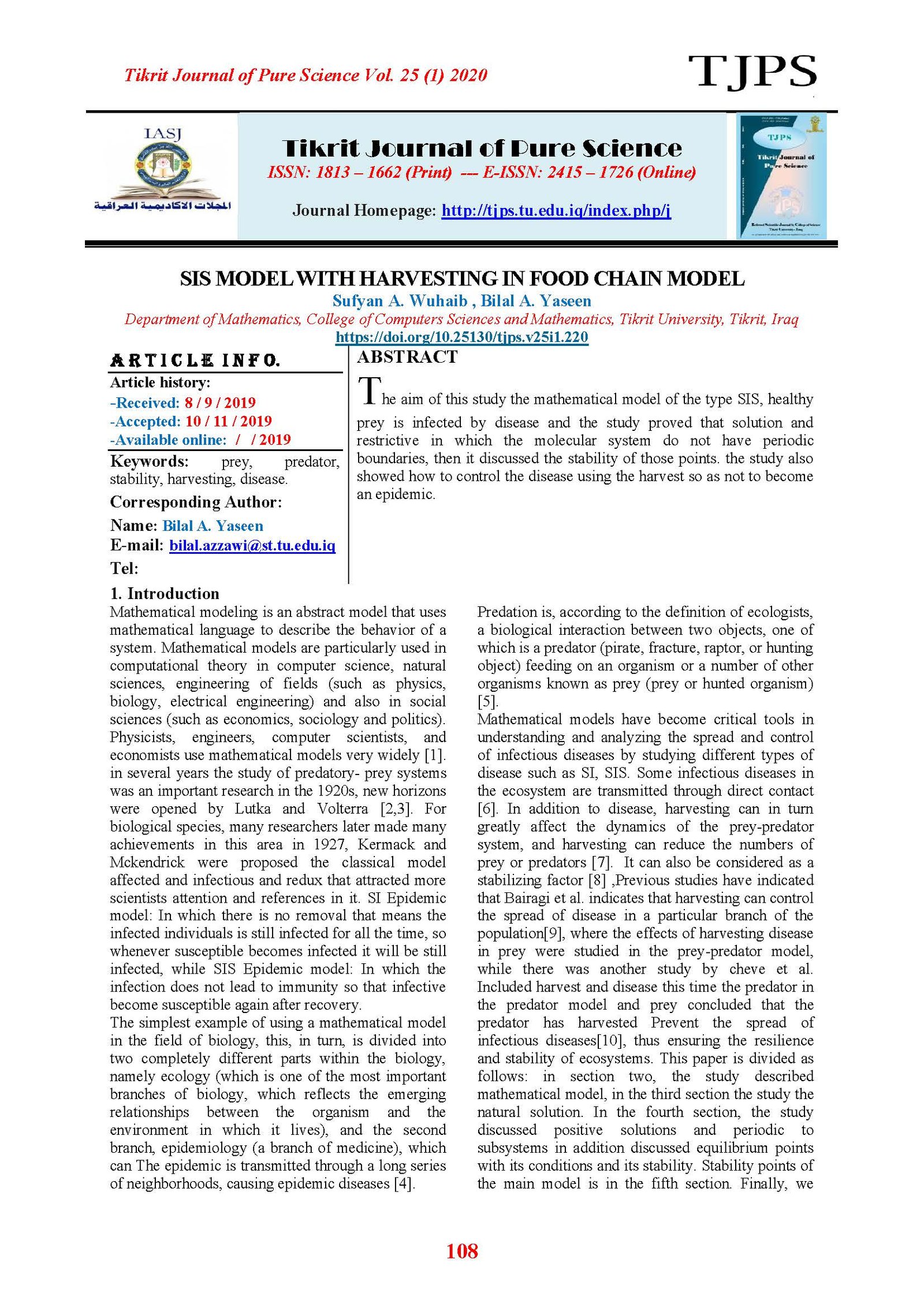SIS MODEL WITH HARVESTING IN FOOD CHAIN MODEL
Main Article Content
Abstract
The aim of this study the mathematical model of the type SIS, healthy prey is infected by disease and the study proved that solution and restrictive in which the molecular system do not have periodic boundaries, then it discussed the stability of those points. the study also showed how to control the disease using the harvest so as not to become an epidemic.
Article Details

This work is licensed under a Creative Commons Attribution 4.0 International License.
Tikrit Journal of Pure Science is licensed under the Creative Commons Attribution 4.0 International License, which allows users to copy, create extracts, abstracts, and new works from the article, alter and revise the article, and make commercial use of the article (including reuse and/or resale of the article by commercial entities), provided the user gives appropriate credit (with a link to the formal publication through the relevant DOI), provides a link to the license, indicates if changes were made, and the licensor is not represented as endorsing the use made of the work. The authors hold the copyright for their published work on the Tikrit J. Pure Sci. website, while Tikrit J. Pure Sci. is responsible for appreciate citation of their work, which is released under CC-BY-4.0, enabling the unrestricted use, distribution, and reproduction of an article in any medium, provided that the original work is properly cited.
References
[1] Pyke, G. H. (1984). Optimal Foraging Theory: A Critical Review. Annual Review of Ecology and Systematics. 15: 523–575.
[2] Lotka, A. (1925). Element of Physical Biology. Williams and Wilkins. Baltimore.
[3] Volterra, V. (1928). Variations and fluctuations of the number of individuals in animal species living together. Animal Ecol. 3(1). 3–51.
[4] Anderson, R.M. and May, R.M. (1986). The invasion, persistence and spread of infectious diseases within animal and plant communities. Philosophical Transactions of Royal Society of London. Series B, Biological Sciences,314. 533–570.
[5] Begon, M. and Townsend Harper, J. (1996) Ecology: Individuals, populations and communities , 3rd edn. Blackwell Science, London.
[6] Naji, R. K. and Mustafa, A. N. (2012). The Dynamics of an Eco-Epidemiological Model with Nonlinear Incidence Rate. Journal of Applied Mathematics, Article ID 852631,24 pages.
[7] Clark, C. W. (1976). Mathematical Bioeconomics, the optimal control of renewable resources . New York John Wiley.
[8] Goh, B. S; Leitmann, G. and Vincent, T. L. (1974). Optimal control of a prey-predator system. Mathematical biosciences 19(3): 263–286.
[9] Bairagi, N; Chaudhuri, S. and Chattopadhyay, J.(2009). Harvesting as a Disease Control Measure in An Eco-epidemiological System - a Theoretical Study. Mathematical Biosciences, 217, 134-144.
[10] Cheve, M; Congar, R. and Diop, P.A.(2010). Resilience and Stability of Harvested Predator-Prey Systems to Infectious Disease in the Predator. Available from http://www.cerdi.org/uploads/sfCmsContent/html/323/
[11] Birkoff, G. C. R. (1982), Ordinary Differential Equations,Ginn.
[12] Freedman, H. and Waltman, P. (1984). Persistence in models of three interacting predator-prey populations, Mathematical biosciences, 68(2): 213-231.
